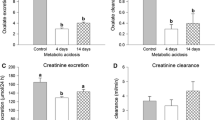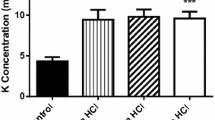Abstract
Glicentin (GLIC) and oxyntomodulin (OXM) arereleased from the ileum and colon during digestion. Bothhormones reduce fluid and proton secretion in thestomach. The luminal concentration of sodium andchloride underlying the nutrient absorption, the effectof OXM on electrolyte transport through the smallintestine, was assessed in vivo using ligated loops andin vitro using Ussing chambers. In vivo , a zero transport state, estimated by the net water,chloride, and sodium fluxes, was observed when an 80 mMNaCl normoosmolar solution (274 mosm) was administeredintraluminally. Active secretion was observed with hyperosmotic challenge (474 mosm). Theamplitude of this active secretion increased 2.5- to3-fold when an electrogenic challenge (NaCl 40 mM) wassubstituted to the hyperosmotic one. OXM (800 fmol/ml plasma) did not modify the basal transport inthe duodenum or in the jejunum (t = 45 min). When activesecretion was induced by the hyperosmotic challenge, OXM(200 fmol/ml plasma) had no effect on duodenal or jejunal transport (t = 50 min). When activesecretion was induced by an electrogenic challenge, OXM(300 fmol/ml plasma) preferentially reduced thehydromineral transport in jejunum. In vitro , OXM also induced a reduction in the ion transporttowards the jejunal lumen (EC50 = 20 pM), theamplitude of which depended upon the integrity of thetetrodotoxin-sensitive neurons. In conclusion, OXM wasable to reduce the large secretion induced in ratjejunum in vivo by an electrogenic gradient. In vitro,the antisecretory effect of OXM was partly mediated bythe neurons present in the intrajejunal wall.
Similar content being viewed by others
REFERENCES
Sundler F, Ekblad E, Hakanson R: Localization and colocalization of gastrointestinal peptides. Gastrointestinal regulatory peptides, Ed. David R Brown, Publisher, Springer-Verlag, Berlin-Heidelberg, 1993
Kervran A, Blache P, Bataille D: Distribution of oxyntomodulin and glucagon in the gastrointestinal tract and the plasma of the rat. Endocrinology 121:704-713, 1987
Holst JJ, Orskov C: Glucagon and other proglucagon derived peptides. InGut Peptides: Biochemistry and Physiology. J Walsh, G Dockray (eds). New York, Raven Press 1994, pp 305-340
Bataille D, Coudray AM, Carlqvist M, Rosselin G, Mutt V: Isolation of glucagon-37 (bioactiveente roglucagon/oxyntomodulin) from porcine jejunoileum. Isolation of the peptide. FEBS Lett 146:73-78, 1982
Thim L, Moody AJ: The primary structure of porcine glicentin (proglucagon):Regul Pept 2:139-151, 1981
Böttger I, Dobbs R, Faloona G, Unger R: The effects of triglyce ride absorption upon glucagon, insulin and gut glucagon-like immunoreactivity: J Clin Invest 52:2532-2541, 1973
Ohneda A: Response of plasma glicentin to intraduodenal administration of glucose in piglets: Diabetes Res Clin Pract 3:97-102, 1987
Le Quellec A, Kervran A, Blache P, Ciurana AJ, Bataille D: Oxyntomodulin-like immunore activity: Diurnal profile of a new potential enterogastrone. J Clin Endocrinol Metab 74:1405-1409, 1992
Bataille D: Oxyntomodulin and its related peptides: Gastrointestinal regulatory peptides, Ed. David R Brown, Publisher, Springer-Ve rlag, Berlin-Heidelberg, 1993
Schjoldager B, Mortensen PE, Myhre J, Christiansen J, Holst JJ: Oxyntomodulin from distal gut. Role in regulation of gastric and pancre atic functions. Dig Dis Sci 34:1411-1419, 1989
Kirkegard P, Moody AJ, Holst JJ, Loud FB, Olsen PS, Christiansen J: Glicentin inhibits gastric acid secretion in the rat. Nature 297:156-157, 1982
Jarrousse C, Carles-Bonnet C, Niel H, Bataille D: Activity of oxyntomodulin on gastric acid secretion by oxyntomodulin and its (19-37) fragment in the conscious rat. Am J Physiol 264:G816-G823, 1993
Jarrousse C, Carles-Bonnet C, Niel H, Bataille D: Activity of oxyntomodulin on gastric acid secretion induced by histamine or a meal in the rat. Peptides 15:1415-1420, 1994
Rodier G, Magous R, Mochizuki T, Martinez J, Le Nguyen D, Bali JP, Bataille D, Jarrousse C: Effect of glicentin, oxyntomodulin and re lated peptides on isolated gastric smooth muscle cells. Pflüegers Arch-Eur J Physiol 434:729-734, 1997
Biedzinski TM, Bataille D, Devaux MA, Sarles H: The effect of oxyntomodulin (glucagon-37) and glucagon on exocrine pancre atic secretion in the conscious rat. Peptides 8:967-972, 1987
Ferraris RP, Yasharpour S, Lloyd K, Mirzayan R, Diamond J: Luminal glucose concentrations in the gut under normal conditions. Am J Physiol 259:G822-G837, 1990
Audousset-Puech MP, Dufour M, Kervran A, Jarrousse C, Castro B, Bataille D, Martinez J: Solid-phase peptide synthesis of human (Nle-27)-oxyntomodulin. Pre liminary evaluation of its biological activities. FEBS Lett 200:181-185, 1986
Mochizuki T, Ohshima K, Takatsuka N, Kakuyama H, Iguchi K, Yanaihara C, Yanaihara N: Total synthe sis and some properties of human glicentin. InVasoactive Intestinal Peptide, Pituitary Adenylate Cyclase Activating Polypeptide, and Related Regulatory Peptides. G Rosselin (ed). World Scientific, Singapore 1994, pp. 51- 61
Anini Y, Chariot J, Nagain C, Jarrousse C, Kervran A, Bataille D, Roze C: Oxyntomodulin 19-37, but not tGLP1, inhibits neurally stimulated pancreatic secretion at doses mimicking post-prandial plasma oxyntomodulin-like immunoreactivity in the rat. Digestion 58:174, 1997
Ussing HH, Zerahn K: Active transport of sodium as source of electric current in the short-circuited isolated frog skin. Acta Physiol Scand 23:110-127, 1951
Eto B, Boisset M, Eden P, Balasubramaniam A, Desjeux J-F: Effect of peptide YY and its analogs on chloride ion secretion in fed and fasted rat jejunum. Peptides 16:1403-1409, 1995
Grubb BR: Ion transport across the jejunum in normal and cystic fibrosismice. Am J Physiol 268:G505-G513, 1995
Holst JJ, Rasmussen TN, Harling H, Schmidt P: Effect of intestinal inhibitory peptides on vagally induced secretion from isolated perfused porcine pancreas. Pancreas 8:80-87, 1993
Mei N: Intestinal chemosensitivity. Physiol Rev 62:211- 237, 1985
Grundy D, Scratcherd T: Sensory afferents from the gastrointestinal tract. InHandbook of Physiology, Section 6, The Gastrointestinal System, Vol I, Motility and Circulation, Part 1. SG Schultz (ed) Bethesda, Maryland, American Physiological Society, 1989, pp 593-620
Parsons DS, Wingate DL: The effect of osmotic gradients on fluid transfert across rat intestine in vitro. Biochim Biophys Acta 46:170-183, 1961
Grim E: Water and ele ctrolyte flux rates in the duodenum, jejunum, ileum and colon and effects of osmolarity. Am J Dig Dis 7:17-27, 1962
Davis G, Santa Ana C, Morawski S, Fordtran J: Permeability characteristics of human jejunum, ileum, proximal colon and distal colon: results of potential difference measurements and unidirectional fluxes. Gastroenterology 83:844-850, 1982
Chikh-Issa AR, Charpin G, Dumas C, Nicol P, Pansu D, Descroix-Vagne M: Comparative duodenal, jejunal and ileal responses to luminal saline load. Reprod Nutr Dev 33:151- 164, 1993
Bloom SR, Royston CM, Thompson JP: Enteroglucagon release in the dumping syndrome. Lancet 2:789-791, 1972
Barbezat GO: Stimulation of intestinal secretion by polypeptide hormones. Scand J Gastroenterol 8(suppl 22):1-21, 1973
Bond JH, Levitt MD: Use of microspheres to measure small intestinal villus blood flow in the dog: Am J Physiol 236:577- 585, 1979
Lundberg JM, Brodin E, Huz X, Saria A: Vascular permeability change s and smooth muscle contraction in relation to capsaicin-sensitive substance P afferents in the guinea-pig. Acta Physiol Scand 120:217-227, 1984
Kaufman M, Dinno M, Huang K: Effect of glucagon on ion transport in mouse intestine. Am J Physiol 238:G491-G494, 1980
Holtug K, Hansen MB, Skadhauge E: Experimental studies of intestinal ion and water transport. Scand J Gastroenterol 31(suppl 216):95-110, 1996
Li Y, Owyang C: Pancreatic secretion evoked by cholecystokinin and non-cholecystokinin-dependent duodenal stimuli via vagal afferent fi bers in the rat. J Physiol 494(3):773- 782, 1996
Kilander AF, Dotevall G, Lindstedt G, Lundberg PA: Plasma enteroglucagon related to malabsorption in coeliac disease. Gut 25:629-635, 1984
Besterman HS, Adrian TE, Mallinson CN, Christophides ND, Sarson DL, Pera A, Lombardo L, Modigliani R, Bloom SR: Gut hormone release after intestinal resection. Gut 23:854- 861, 1982
Besterman HS, Christofides ND, Welsby PD, Adrian TE, Sarson DL, Bloom SR: Gut hormones in acute diarrhoea. Gut 24:665-671, 1983
Rights and permissions
About this article
Cite this article
Beauclair, F., Eto, B., Pansu, D. et al. Oxyntomodulin Reduces Hydromineral Transport Through Rat Small Intestine. Dig Dis Sci 43, 1814–1823 (1998). https://doi.org/10.1023/A:1018804307972
Issue Date:
DOI: https://doi.org/10.1023/A:1018804307972




